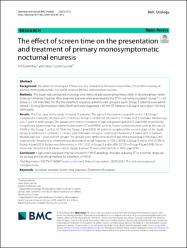| dc.contributor.author | Demirbaş, Arif | |
| dc.contributor.author | Gerçek, Hacer Gizem | |
| dc.date.accessioned | 2023-04-18T12:20:13Z | |
| dc.date.available | 2023-04-18T12:20:13Z | |
| dc.date.issued | 2023 | en_US |
| dc.identifier.citation | Demirbas, A., & Gercek, H. G. (2023). The effect of screen time on the presentation and treatment of primary monosymptomatic nocturnal enuresis. BMC urology, 23(1), 1-5. | en_US |
| dc.identifier.issn | 1471-2490 | |
| dc.identifier.uri | https://dx.doi.org/10.1186/s12894-023-01184-y. | |
| dc.identifier.uri | https://hdl.handle.net/20.500.12933/1478 | |
| dc.description.abstract | Background: We aimed to investigate if there was any relationship between screen time (ST) and the severity of primary monosymptomatic nocturnal enuresis (PMNE) and treatment success.
Methods: This study was conducted in urology and child and adolescent phsychiatry clinic in Afyonkarahisar Health Sciences University Hospital. After diagnosis patients were seperated by the ST for exploring causation. Group 1 > 120, Group 2 < 120 (min/day). For the the treatment response, patients were grouped again. Group 3 patients were administered 120 mcg Desmopressin Melt (DeM) and were requested < 60 min ST. Patients in Group 4 were given 120 mcg DeM solely.
Results: The first stage of the study included 71 patients. The ages of the patients ranged from 6 to 13. Group 1 comprised 47 patients, 26 males and 21 females. Group 2 comprised 24 patients,11 males and 13 famales. Median age was 7 years in both groups. The groups were similar in respect of age and gender (p = 0.670, p = 0.449, respectively). A significant relationship was determined between ST and PMNE severity. Severe symptoms were seen at the rate of 42.6% in the Group 1, and at 16.7% in the Group 2 (p = 0.033). 44 patients completed the second stage of the study. Group 3 comprised 21 patients, 11 males and 10 females. Group 4 comprised 23 patients,11 males and 12 famales. Median age was 7 years in both groups. The groups were similar in respect of age and gender (p = 0.708, p = 0.765, respectively). Response to treatment was determined as full response in 70% (14/20) in Group 3 and in 31% (5/16) in Group 4 (p = 0.021). Failure was determined in 5% (1/21) in Group 3 and in 30% (7/23) in Group 4 (p = 0.048). Recurrence was determined at a lower rate in Group 3 where ST was restricted (7% vs. 60%, p = 0.037).
Conclusion: High screen exposure may be a factor for PMNE aetiology. And also reducing ST to a normal range can be an easy and beneficial method for treatment of PMNE. Trial Registration ISRCTN15760867( www.isrctn.com ). Date of registration: 23/05/2022. This trial was registered retrospectively. | en_US |
| dc.language.iso | eng | en_US |
| dc.publisher | BioMed Central | en_US |
| dc.relation.isversionof | 10.1186/s12894-023-01184-y. | en_US |
| dc.rights | info:eu-repo/semantics/openAccess | en_US |
| dc.subject | Nocturnal Enuresis | en_US |
| dc.subject | Screen Time Exposure | en_US |
| dc.subject | Treatment of Enuresis | en_US |
| dc.title | The effect of screen time on the presentation and treatment of primary monosymptomatic nocturnal enuresis | en_US |
| dc.type | article | en_US |
| dc.authorid | 0000-0003-4984-3722 | en_US |
| dc.department | AFSÜ, Tıp Fakültesi, Cerrahi Tıp Bilimleri Bölümü, Üroloji Ana Bilim Dalı | en_US |
| dc.contributor.institutionauthor | Demirbaş, Arif | |
| dc.contributor.institutionauthor | Gerçek, Hacer Gizem | |
| dc.identifier.volume | 23 | en_US |
| dc.identifier.issue | 1 | en_US |
| dc.relation.journal | BMC Urology | en_US |
| dc.relation.publicationcategory | Makale - Uluslararası Hakemli Dergi - Kurum Öğretim Elemanı | en_US |
















